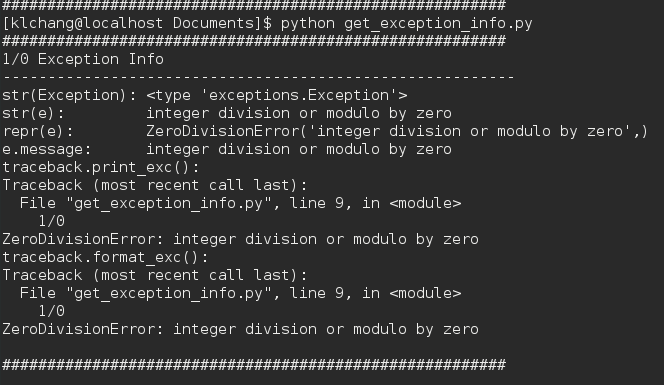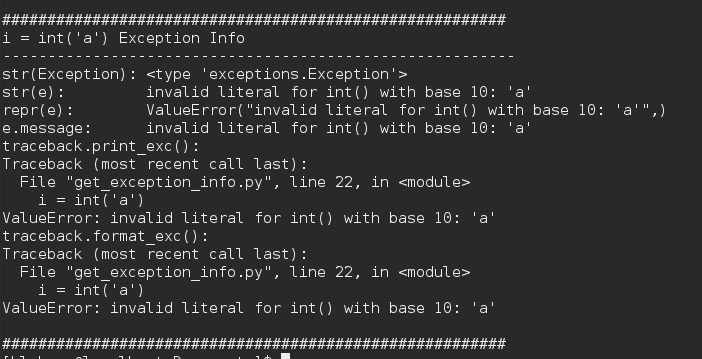异常信息的获取对于程序的调试非常重要,可以有助于快速定位有错误程序语句的位置。下面介绍几种python中获取异常信息的方法,这里获取异常(Exception)信息采用try...except...程序结构。如下所示
try: ... except Exception, e: ...
1、str(e)
返回字符串类型,只给出异常信息,不包括异常信息的类型,如1/0的异常信息
'integer division or modulo by zero'
2、repr(e)
给出较全的异常信息,包括异常信息的类型,如1/0的异常信息
"ZeroDivisionError('integer division or modulo by zero',)"
3、e.message
获得的信息同str(e)
4、采用traceback模块
需要导入traceback模块,此时获取的信息最全,与python命令行运行程序出现错误信息一致。使用traceback.print_exc()打印异常信息到标准错误,就像没有获取一样,或者使用traceback.format_exc()将同样的输出获取为字符串。你可以向这些函数传递各种各样的参数来限制输出,或者重新打印到像文件类型的对象。
示例如下:
import traceback print '########################################################' print "1/0 Exception Info" print '---------------------------------------------------------' try: 1/0 except Exception, e: print 'str(Exception): ', str(Exception) print 'str(e): ', str(e) print 'repr(e): ', repr(e) print 'e.message: ', e.message print 'traceback.print_exc():'; traceback.print_exc() print 'traceback.format_exc(): %s' % traceback.format_exc() print '########################################################' print ' ########################################################' print "i = int('a') Exception Info" print '---------------------------------------------------------' try: i = int('a') except Exception, e: print 'str(Exception): ', str(Exception) print 'str(e): ', str(e) print 'repr(e): ', repr(e) print 'e.message: ', e.message print 'traceback.print_exc():'; traceback.print_exc() print 'traceback.format_exc(): %s' % traceback.format_exc() print '########################################################'
示例结果


补充 1(更新于2020.8.1)
对于 Python 3 的 Exception,与 Python 2 的 Exception 相比,有两个需要注意的地方:
1)在 Python 3 Exception 的 except 子句中,不支持使用逗号 ',' 分隔 Exception 和 e,所以需要采用 as 关键词进行替换;
2)与 Python 2 Exception 类相比,Python 3 Exception 类没有 message 成员变量。针对这个问题,可以采用 sys.exc_info() 方法获取得到相关的异常信息。以 1/0 异常处理为例,更新的程序如下:
import sys
import traceback
print('########################################################')
print("1/0 Exception Info")
print('---------------------------------------------------------')
try:
1/0
except Exception as e:
print('str(Exception): ', str(Exception))
print('str(e): ', str(e))
print('repr(e): ', repr(e))
# Get information about the exception that is currently being handled
exc_type, exc_value, exc_traceback = sys.exc_info()
print('e.message: ', exc_value)
print("Note, object e and exc of Class %s is %s the same." %
(type(exc_value), ('not', '')[exc_value is e]))
print('traceback.print_exc(): ', traceback.print_exc())
print('traceback.format_exc():
%s' % traceback.format_exc())
print('########################################################')
注:
1) sys.exc_info() 方法可以获取正在处理的异常信息,即 except 子句正在处理的异常,其返回值为一个tuple类型的三元组(exc_type, exc_value, exc_traceback),其中,exc_type为获取到的异常类型;exc_value为该异常类型对象;exc_traceback为一个 traceback 对象,包含异常最初发生的调用栈信息。
2) as 关键字以及 sys.exc_info() 方法对于 Python 2 同样适用。
3) 程序中的变量 e 和 exc_value 是同一个异常类型实例对象。
参考资料: